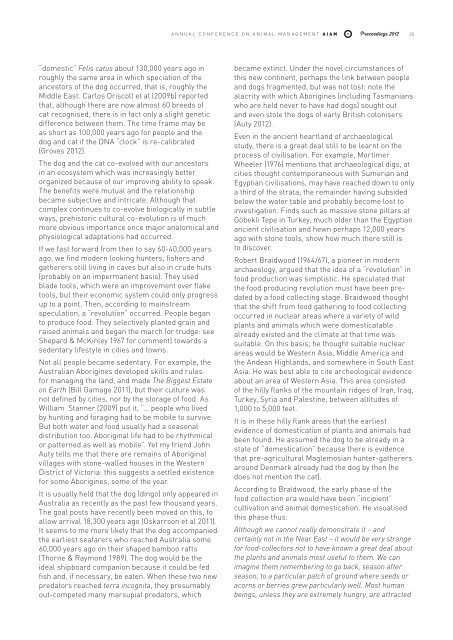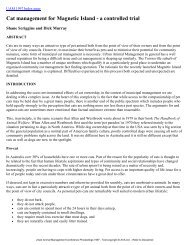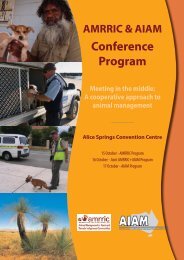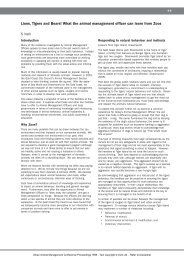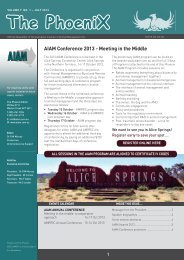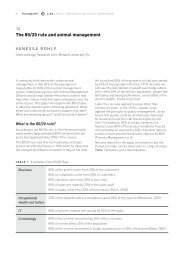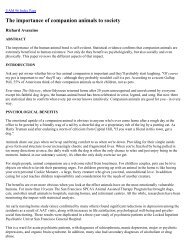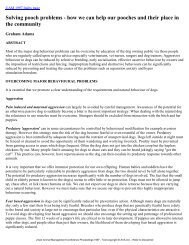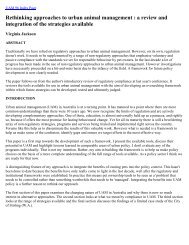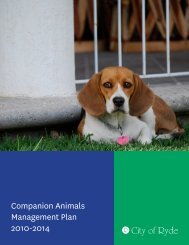Proceedings OF ThE - Australian Institute of Animal Management Inc
Proceedings OF ThE - Australian Institute of Animal Management Inc
Proceedings OF ThE - Australian Institute of Animal Management Inc
You also want an ePaper? Increase the reach of your titles
YUMPU automatically turns print PDFs into web optimized ePapers that Google loves.
Annual Conference on <strong>Animal</strong> <strong>Management</strong> AIAM <strong>Proceedings</strong> 2012 25<br />
“domestic” Felis catus about 130,000 years ago in<br />
roughly the same area in which speciation <strong>of</strong> the<br />
ancestors <strong>of</strong> the dog occurred, that is, roughly the<br />
Middle East. Carlos Driscoll et al (2009b) reported<br />
that, although there are now almost 60 breeds <strong>of</strong><br />
cat recognised, there is in fact only a slight genetic<br />
difference between them. The time frame may be<br />
as short as 100,000 years ago for people and the<br />
dog and cat if the DNA “clock” is re-calibrated<br />
(Groves 2012).<br />
The dog and the cat co-evolved with our ancestors<br />
in an ecosystem which was increasingly better<br />
organized because <strong>of</strong> our improving ability to speak.<br />
The benefits were mutual and the relationship<br />
became subjective and intricate. Although that<br />
complex continues to co-evolve biologically in subtle<br />
ways, prehistoric cultural co-evolution is <strong>of</strong> much<br />
more obvious importance once major anatomical and<br />
physiological adaptations had occurred.<br />
If we fast forward from then to say 60-40,000 years<br />
ago, we find modern looking hunters, fishers and<br />
gatherers still living in caves but also in crude huts<br />
(probably on an impermanent basis). They used<br />
blade tools, which were an improvement over flake<br />
tools, but their economic system could only progress<br />
up to a point. Then, according to mainstream<br />
speculation, a “revolution” occurred. People began<br />
to produce food. They selectively planted grain and<br />
raised animals and began the march (or trudge: see<br />
Shepard & McKinley 1967 for comment) towards a<br />
sedentary lifestyle in cities and towns.<br />
Not all people became sedentary. For example, the<br />
<strong>Australian</strong> Aborigines developed skills and rules<br />
for managing the land, and made The Biggest Estate<br />
on Earth (Bill Gamage 2011), but their culture was<br />
not defined by cities, nor by the storage <strong>of</strong> food. As<br />
William Stanner (2009) put it, “… people who lived<br />
by hunting and foraging had to be mobile to survive.<br />
But both water and food usually had a seasonal<br />
distribution too. Aboriginal life had to be rhythmical<br />
or patterned as well as mobile”. Yet my friend John<br />
Auty tells me that there are remains <strong>of</strong> Aboriginal<br />
villages with stone-walled houses in the Western<br />
District <strong>of</strong> Victoria: this suggests a settled existence<br />
for some Aborigines, some <strong>of</strong> the year.<br />
It is usually held that the dog (dingo) only appeared in<br />
Australia as recently as the past few thousand years.<br />
The goal posts have recently been moved on this, to<br />
allow arrival 18,300 years ago (Oskarrson et al 2011).<br />
It seems to me more likely that the dog accompanied<br />
the earliest seafarers who reached Australia some<br />
60,000 years ago on their shaped bamboo rafts<br />
(Thorne & Raymond 1989). The dog would be the<br />
ideal shipboard companion because it could be fed<br />
fish and, if necessary, be eaten. When these two new<br />
predators reached terra incognita, they presumably<br />
out-competed many marsupial predators, which<br />
became extinct. Under the novel circumstances <strong>of</strong><br />
this new continent, perhaps the link between people<br />
and dogs fragmented, but was not lost: note the<br />
alacrity with which Aborigines (including Tasmanians<br />
who are held never to have had dogs) sought out<br />
and even stole the dogs <strong>of</strong> early British colonisers<br />
(Auty 2012).<br />
Even in the ancient heartland <strong>of</strong> archaeological<br />
study, there is a great deal still to be learnt on the<br />
process <strong>of</strong> civilisation. For example, Mortimer<br />
Wheeler (1976) mentions that archaeological digs, at<br />
cities thought contemporaneous with Sumerian and<br />
Egyptian civilisations, may have reached down to only<br />
a third <strong>of</strong> the strata, the remainder having subsided<br />
below the water table and probably become lost to<br />
investigation. Finds such as massive stone pillars at<br />
Göbekli Tepe in Turkey, much older than the Egyptian<br />
ancient civilisation and hewn perhaps 12,000 years<br />
ago with stone tools, show how much there still is<br />
to discover.<br />
Robert Braidwood (1964/67), a pioneer in modern<br />
archaeology, argued that the idea <strong>of</strong> a “revolution” in<br />
food production was simplistic. He speculated that<br />
the food producing revolution must have been predated<br />
by a food collecting stage. Braidwood thought<br />
that the shift from food gathering to food collecting<br />
occurred in nuclear areas where a variety <strong>of</strong> wild<br />
plants and animals which were domesticatable<br />
already existed and the climate at that time was<br />
suitable. On this basis, he thought suitable nuclear<br />
areas would be Western Asia, Middle America and<br />
the Andean Highlands, and somewhere in South East<br />
Asia. He was best able to cite archeological evidence<br />
about an area <strong>of</strong> Western Asia. This area consisted<br />
<strong>of</strong> the hilly flanks <strong>of</strong> the mountain ridges <strong>of</strong> Iran, Iraq,<br />
Turkey, Syria and Palestine, between altitudes <strong>of</strong><br />
1,000 to 5,000 feet.<br />
It is in these hilly flank areas that the earliest<br />
evidence <strong>of</strong> domestication <strong>of</strong> plants and animals had<br />
been found. He assumed the dog to be already in a<br />
state <strong>of</strong> “domestication” because there is evidence<br />
that pre-agricultural Maglemosian hunter-gatherers<br />
around Denmark already had the dog by then (he<br />
does not mention the cat).<br />
According to Braidwood, the early phase <strong>of</strong> the<br />
food collection era would have been “incipient”<br />
cultivation and animal domestication. He visualised<br />
this phase thus:<br />
Although we cannot really demonstrate it − and<br />
certainly not in the Near East − it would be very strange<br />
for food-collectors not to have known a great deal about<br />
the plants and animals most useful to them. We can<br />
imagine them remembering to go back, season after<br />
season, to a particular patch <strong>of</strong> ground where seeds or<br />
acorns or berries grew particularly well. Most human<br />
beings, unless they are extremely hungry, are attracted


